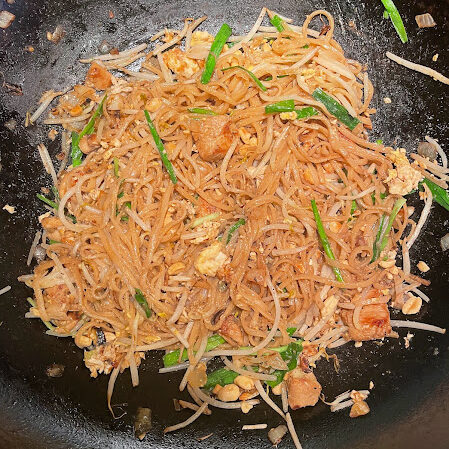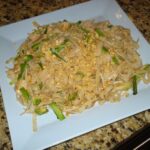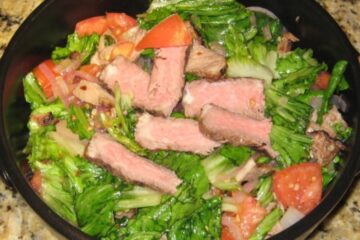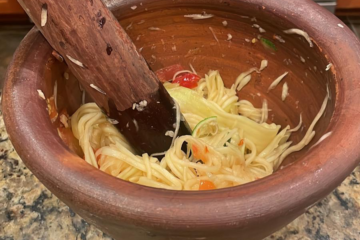Pad Thai is one of the most popular Thai dishes that has made its way from the streets of Thailand to the menus of restaurants worldwide. It is a great comfort food, packed with flavors and textures that make it a favorite among foodies. With a little practice, you can learn to make it at home!
Pad Thai Sauce
Pad Thai sauce is a great example of the balance of Thai flavors; in this case, sour, salty and sweet. Not to be forgotten – savory is inherent with the fish sauce and the spicy is optional.
Roughly speaking, you want to use equal parts of salty, sweet and sour. Because ingredients can differ in taste (particularly tamarind paste), measurements are just a guideline.
- Salty – Fish sauce. This is traditional. If the taste is too strong for you, you can also replace some of the fish sauce with soy sauce for another salty component. Note that this is non-traditional, but common especially in more Americanized versions.
- Sweet – Palm sugar if you can find it. Otherwise brown sugar is a good substitute.
- Sour – Tamarind is traditional. Some recipes also use rice vinegar or fresh lime juice. I like the combination of all 3. If you can’t find Tamarind, use more rice vinegar and lime juice.
Mix everything together then taste. You should be able to pick out salty, sweet and sour. If one is missing, add more of that ingredient until the taste is balanced. I have noticed that many restaurant versions of Pad Thai in the US are very sweet. This is not how traditional Pad Thai should taste. If sweet is the predominant flavor, there is too much sugar. Balance of flavors is the key to authentic good Pad Thai.
I typically make a few cups of a sauce at a time that I keep in my refrigerator. If I plan to keep it for over a week, I omit the fresh lime juice and use more tamarind and vinegar which will keep longer before spoiling.
Preparation
Once you’ve made the sauce, assemble all other ingredients. This comes together quickly, and you don’t want to be scrambling for ingredients when you’re in the middle of cooking.
Soak the rice noodles in warm water for about half an hour, until they are pliable, then drain and set them aside. DO NOT follow the instructions on the package and boil the noodles. You want them just pliable, not cooked, or you are guaranteed to get mushy noodles.
Prep your protein. If you are using chicken, pork or beef, marinate with a little soy sauce and a dusting of cornstarch. This better allows the protein to sear. If using raw shrimp, just pat dry.
Cut your garlic chives, crush your peanuts and cut your lime wedges.
A note that traditional Pad Thai normally includes tofu, dried shrimp and sweet preserved daikon radishes. I sometimes will add the tofu, but I don’t add the dried shrimp or sweet radishes. This is just personal preference. My mom didn’t add these ingredients, probably because they were not readily available in our area.
You can also add some spice to your dish by using chili oil or fresh sliced chili peppers. I typically serve these on the side so people can add as they want.
Cooking Pad Thai

Pad Thai comes together very quickly, so it’s important that everything is prepped before you begin cooking. Once you’re ready to cook, understand that Pad Thai will require a bit of technique. If it doesn’t come out perfectly the first time, don’t give up. You’ll learn as you go and will be a pro in no time!
Some important tips to follow for success –
- Be careful not to overload the pan. Stir-frying Pad Thai requires high heat, and overcrowding the pan can lead to steaming instead of stir-frying. This can result in soggy noodles and vegetables instead of the desired crispness. So it’s a good practice to only cook 2-3 portions at one time.
- Too much sauce can overpower the dish. It’s best to start with a small amount and adjust to taste.
- Don’t overcook the protein. Whether you’re using shrimp, chicken, or tofu, it’s essential to cook the protein just until it’s done as overcooking can result in tough, dry, or rubbery texture. If you are uncomfortable timing the addition of each ingredient, cook protein until almost fully cooked and remove before adding noodles to your wok. Then reincorporate protein after noodles are ready.
- Don’t over-stir the noodles, or they will break. Let them set and use tongs to gently toss.
- Vegetables are key. Pad Thai traditionally includes bean sprouts and garlic chives. Neglecting to add enough of these ingredients can result in a heavy dish with lack of texture. Also, the vegetables should be added with the heat turned off so they remain crisp.
So give it a shot. Practice a bit and you will see how easy it is once you get the hang of it!
Pad Thai
Equipment
- Wok
Ingredients
Pad Thai Sauce
- 3 tbsp fish sauce
- 1 tsp dark soy sauce for color
- 2-3 tbsp palm sugar or substitute brown or white sugar
- 1 tbsp tamarind paste
- 1 tbsp rice vinegar
- 1 tbsp fresh lime juice
Other Ingredients
- ½ package rice noodles medium size prefered
- 1 clove garlic minced
- ¼ cup shallots or onion diced
- ½ lb protein of choice shrimp, chicken, pork or beef
- 2 eggs
- 1 cup beansprouts
- ¼ cup peanuts crushed
- ½ cup garlic chives or the green part of scallion cut into 1 inch strips
- 1 lime wedge garnish
Instructions
- Soak rice noodles for 1 hour until pliable
- Prepare Pad Thai sauce by mixing all ingredients and mixing until sugar is disolved. Taste and adjust as needed. You should be able to distinctly taste salty, sour and sweet.
- Heat a small amount of oil in your wok. Add onion and garlic. Saute until slightly softened.
- Add protein of choice and fry until nearly fully cooked.
- Push protein to the side, and add softened noodles. Add half of the prepared sauce. Flip to incorporate the sauce into the noodles, being careful not to stir too much or the noodles will break. If the noodles appear dry, add water a few Tbsp at a time.
- Push the noodles and meat to the side to create and open space in your wok. Add a small amount of oil and crack your eggs into the pan. Break yolks slightly, then fold noodles onto eggs. Let set for 30 seconds without touching.
- Mix everything together and taste. If it needs more flavor, and remaining sauce.
- Remove from heat. Add beansprouts and garlic chives and toss everything together.
- Move to serving plate. Top with a squeeze of fresh lime and crushed peanuts. Serve with lime wedge garnish on the side.




0 Comments